Houha, which grows wild in the Indo-China peninsula, would have originated in India; as a matter of fact, its name adhatoda came from the Tamil, meaning “a plant neglected by the animals”. It is a handsome, evergreen shrub, with large, deep green, brilliant, corrugated spear-shaped leaves. Its flowers are grouped in short tufts at the end of each branch, and each white corolla has two marginal lips, with purple spots. Contrary to what its English and French vernacular names suggest, its fruit are little inedible capsules, which are found at maturity, projecting their little seeds.
In India, this shrub has many usages: medicinal, dye, insecticide; also, it enables the fruit that it envelopes to ripen more quickly. It grows in dry areas and thus contributes to the struggle against soil erosion. We also add that in the West, it is exploited by homoeopathy.
In Lao, tone houha is well-known because in the texts that preside over the construction of a house, the mai houha is “the King Tree of the 4th, 5th, and 6th months”. In a Lao village soukhouane (wedding ceremony), one occasionally sees white houha flowers, which harmonise with others, yellow or orange, wild or cultivated.
Houha is also a recognised medicinal shrub; the Traditional Medicine Research Centre, which distinguishes between a white and a black variety, recommends it to care for eruptive fevers and the pa dong (common illnesses). But the entire shrub would also have anti-spasmodic and expectorant properties.
In the north of the country, after blanching the flowers, one eats them in a salad; but they can also be eaten raw, in which case they are slightly bitter.
Hou ha qui pousse spontanément dans la péninsule indochinoise, serait originaire de l’Inde, son nom adhatoda viendrait d’ailleurs du tamoul désignant « une plante délaissée par les animaux ». C’est un bel arbuste au feuillage persistant, vert foncé brillant, aux grandes feuilles en forme de lance ondulée. Ses fleurs sont groupées en courts épis en bout de branche, chaque corolle blanche a deux lèvres marginées et griffées de pourpre. Ses fruits sont de petites capsules non comestibles, contrairement à ce que peuvent faire penser ses noms vernaculaires anglais et français, qui s’entrouvrent à maturité en projetant au loin des petites graines.
Cette plante a de multiples usages en Inde: médicament, colorant, insecticide ; en outre, elle permet aux fruits qu’elle enveloppe de mûrir plus vite, elle pousse dans les zones arides et apporte ainsi sa contribution à la lutte contre l’érosion des sols. Ajoutons qu’elle est aussi exploitée en Occident par l’homéopathie.
Au Laos tone houha est bien connu puisque dans les textes qui président à la construction d’une maison le mai houha est « l’arbre roi des 4ème, 5ème et 6ème mois ». Dans les soukhouane de village on voit parfois des fleurs blanches de houha qui s’harmonisent avec d’autres, jaunes ou oranges, sauvages ou cultivées.
Houha est aussi une plante médicinale appréciée; L’IMT qui distingue une variété blanche et une variété noire la recommande pour soigner les fièvres éruptives et les pa dong (maladie traditionnelle) ; mais la plante toute entière aurait aussi des propriétés antispasmodique et expectorante.
Dans le Nord du pays on mange les fleurs en salade après les avoir blanchies, mais on peut aussi les manger crues, elles sont alors légèrement amères.
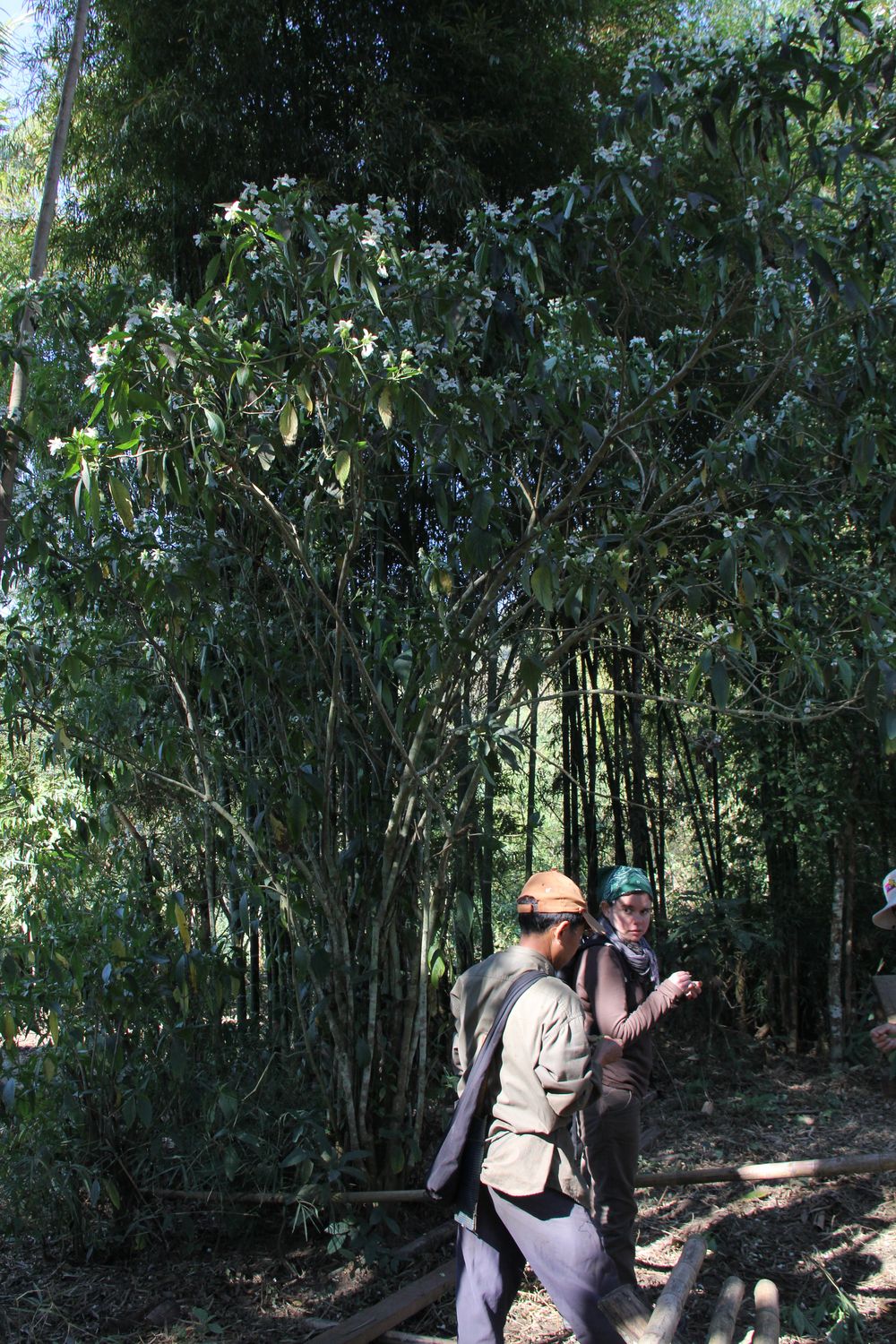
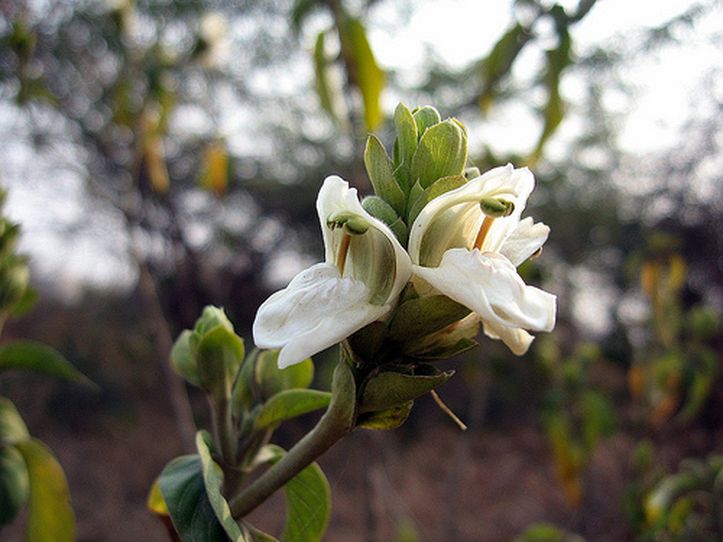
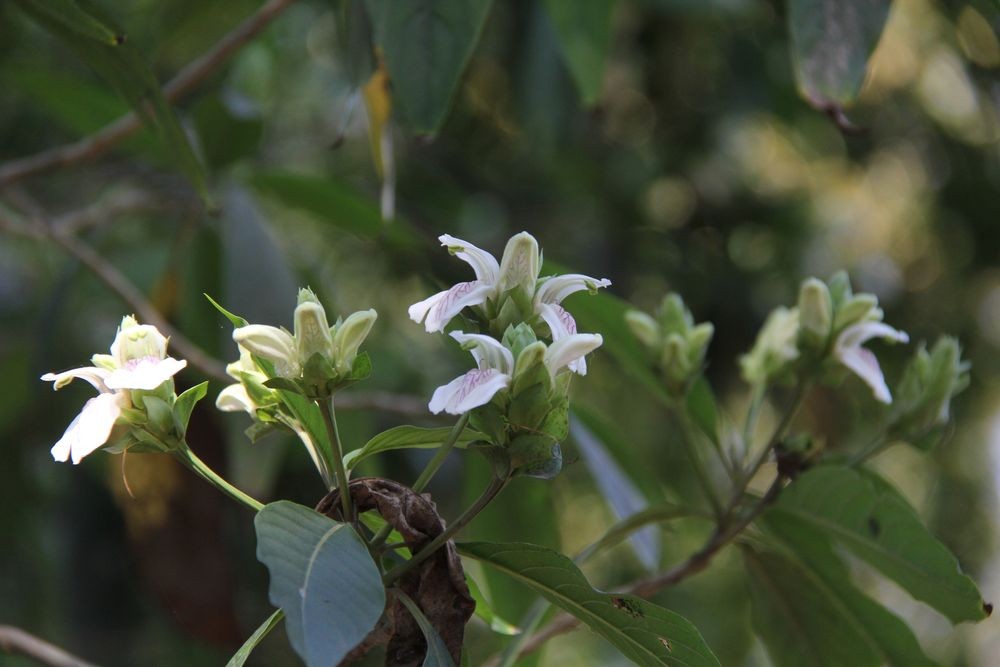
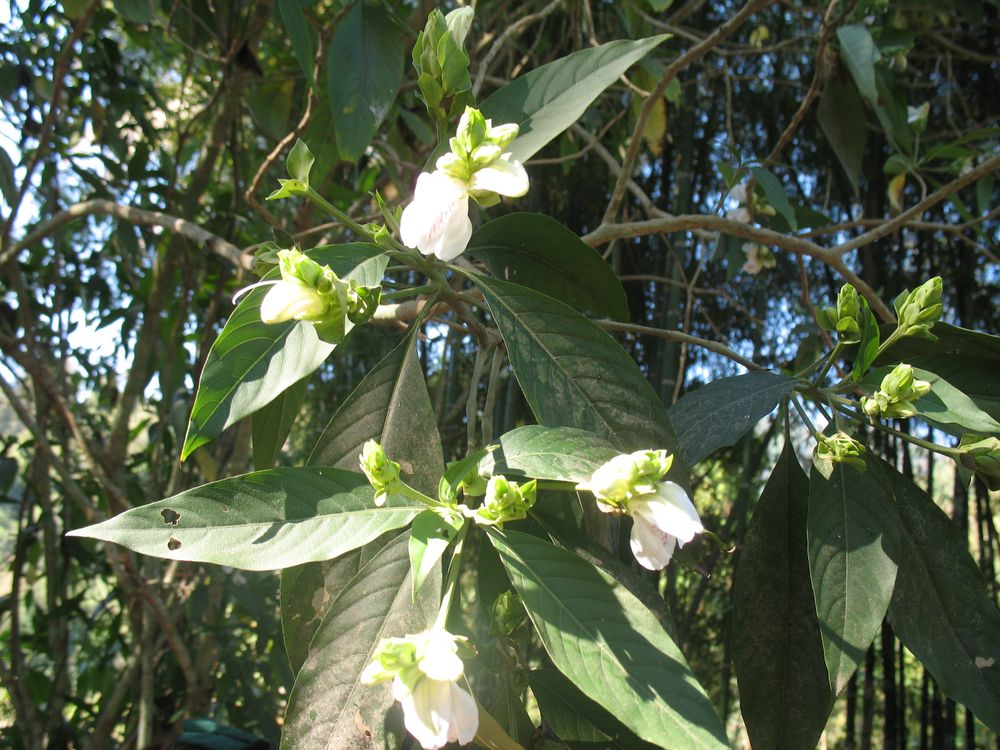
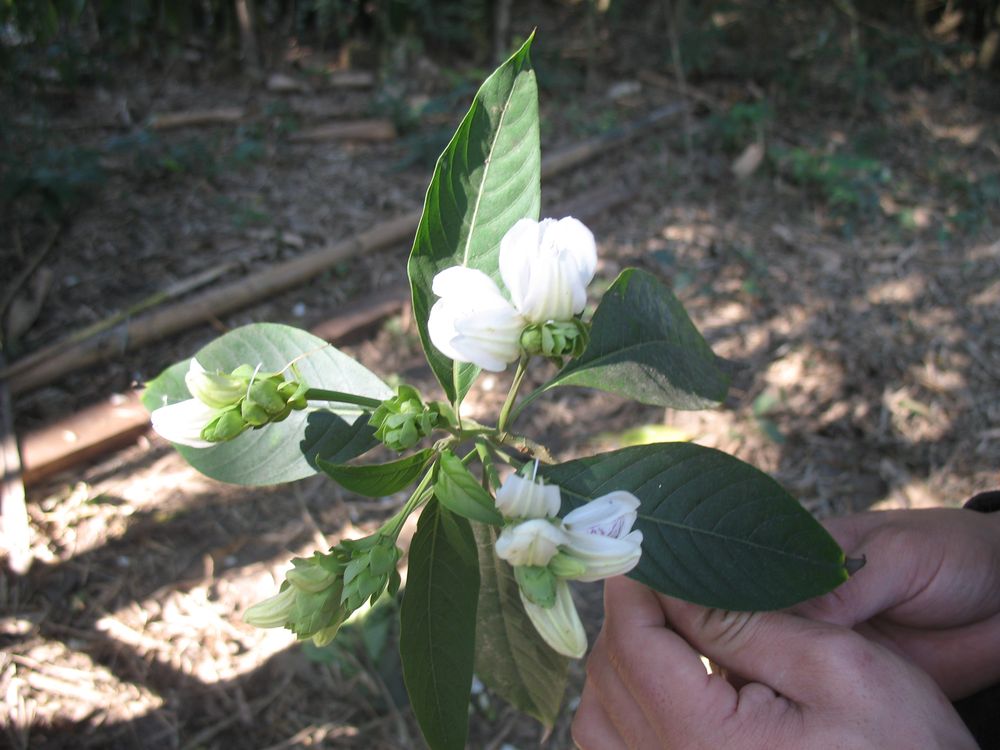
Houha, which grows wild in the Indo-China peninsula, would have originated in India; as a matter of fact, its name adhatoda came from the Tamil, meaning “a plant neglected by the animals”. It is a handsome, evergreen shrub, with large, deep green, brilliant, corrugated spear-shaped leaves. Its flowers are grouped in short tufts at the end of each branch, and each white corolla has two marginal lips, with purple spots. Contrary to what its English and French vernacular names suggest, its fruit are little inedible capsules, which are found at maturity, projecting their little seeds.
In India, this shrub has many usages: medicinal, dye, insecticide; also, it enables the fruit that it envelopes to ripen more quickly. It grows in dry areas and thus contributes to the struggle against soil erosion. We also add that in the West, it is exploited by homoeopathy.
In Lao, tone houha is well-known because in the texts that preside over the construction of a house, the mai houha is “the King Tree of the 4th, 5th, and 6th months”. In a Lao village soukhouane (wedding ceremony), one occasionally sees white houha flowers, which harmonise with others, yellow or orange, wild or cultivated.
Houha is also a recognised medicinal shrub; the Traditional Medicine Research Centre, which distinguishes between a white and a black variety, recommends it to care for eruptive fevers and the pa dong (common illnesses). But the entire shrub would also have anti-spasmodic and expectorant properties.
In the north of the country, after blanching the flowers, one eats them in a salad; but they can also be eaten raw, in which case they are slightly bitter.
Hou ha qui pousse spontanément dans la péninsule indochinoise, serait originaire de l’Inde, son nom adhatoda viendrait d’ailleurs du tamoul désignant « une plante délaissée par les animaux ». C’est un bel arbuste au feuillage persistant, vert foncé brillant, aux grandes feuilles en forme de lance ondulée. Ses fleurs sont groupées en courts épis en bout de branche, chaque corolle blanche a deux lèvres marginées et griffées de pourpre. Ses fruits sont de petites capsules non comestibles, contrairement à ce que peuvent faire penser ses noms vernaculaires anglais et français, qui s’entrouvrent à maturité en projetant au loin des petites graines.
Cette plante a de multiples usages en Inde: médicament, colorant, insecticide ; en outre, elle permet aux fruits qu’elle enveloppe de mûrir plus vite, elle pousse dans les zones arides et apporte ainsi sa contribution à la lutte contre l’érosion des sols. Ajoutons qu’elle est aussi exploitée en Occident par l’homéopathie.
Au Laos tone houha est bien connu puisque dans les textes qui président à la construction d’une maison le mai houha est « l’arbre roi des 4ème, 5ème et 6ème mois ». Dans les soukhouane de village on voit parfois des fleurs blanches de houha qui s’harmonisent avec d’autres, jaunes ou oranges, sauvages ou cultivées.
Houha est aussi une plante médicinale appréciée; L’IMT qui distingue une variété blanche et une variété noire la recommande pour soigner les fièvres éruptives et les pa dong (maladie traditionnelle) ; mais la plante toute entière aurait aussi des propriétés antispasmodique et expectorante.
Dans le Nord du pays on mange les fleurs en salade après les avoir blanchies, mais on peut aussi les manger crues, elles sont alors légèrement amères.










Houha, which grows wild in the Indo-China peninsula, would have originated in India; as a matter of fact, its name adhatoda came from the Tamil, meaning “a plant neglected by the animals”. It is a handsome, evergreen shrub, with large, deep green, brilliant, corrugated spear-shaped leaves. Its flowers are grouped in short tufts at the end of each branch, and each white corolla has two marginal lips, with purple spots. Contrary to what its English and French vernacular names suggest, its fruit are little inedible capsules, which are found at maturity, projecting their little seeds.
In India, this shrub has many usages: medicinal, dye, insecticide; also, it enables the fruit that it envelopes to ripen more quickly. It grows in dry areas and thus contributes to the struggle against soil erosion. We also add that in the West, it is exploited by homoeopathy.
In Lao, tone houha is well-known because in the texts that preside over the construction of a house, the mai houha is “the King Tree of the 4th, 5th, and 6th months”. In a Lao village soukhouane (wedding ceremony), one occasionally sees white houha flowers, which harmonise with others, yellow or orange, wild or cultivated.
Houha is also a recognised medicinal shrub; the Traditional Medicine Research Centre, which distinguishes between a white and a black variety, recommends it to care for eruptive fevers and the pa dong (common illnesses). But the entire shrub would also have anti-spasmodic and expectorant properties.
In the north of the country, after blanching the flowers, one eats them in a salad; but they can also be eaten raw, in which case they are slightly bitter.
Hou ha qui pousse spontanément dans la péninsule indochinoise, serait originaire de l’Inde, son nom adhatoda viendrait d’ailleurs du tamoul désignant « une plante délaissée par les animaux ». C’est un bel arbuste au feuillage persistant, vert foncé brillant, aux grandes feuilles en forme de lance ondulée. Ses fleurs sont groupées en courts épis en bout de branche, chaque corolle blanche a deux lèvres marginées et griffées de pourpre. Ses fruits sont de petites capsules non comestibles, contrairement à ce que peuvent faire penser ses noms vernaculaires anglais et français, qui s’entrouvrent à maturité en projetant au loin des petites graines.
Cette plante a de multiples usages en Inde: médicament, colorant, insecticide ; en outre, elle permet aux fruits qu’elle enveloppe de mûrir plus vite, elle pousse dans les zones arides et apporte ainsi sa contribution à la lutte contre l’érosion des sols. Ajoutons qu’elle est aussi exploitée en Occident par l’homéopathie.
Au Laos tone houha est bien connu puisque dans les textes qui président à la construction d’une maison le mai houha est « l’arbre roi des 4ème, 5ème et 6ème mois ». Dans les soukhouane de village on voit parfois des fleurs blanches de houha qui s’harmonisent avec d’autres, jaunes ou oranges, sauvages ou cultivées.
Houha est aussi une plante médicinale appréciée; L’IMT qui distingue une variété blanche et une variété noire la recommande pour soigner les fièvres éruptives et les pa dong (maladie traditionnelle) ; mais la plante toute entière aurait aussi des propriétés antispasmodique et expectorante.
Dans le Nord du pays on mange les fleurs en salade après les avoir blanchies, mais on peut aussi les manger crues, elles sont alors légèrement amères.


